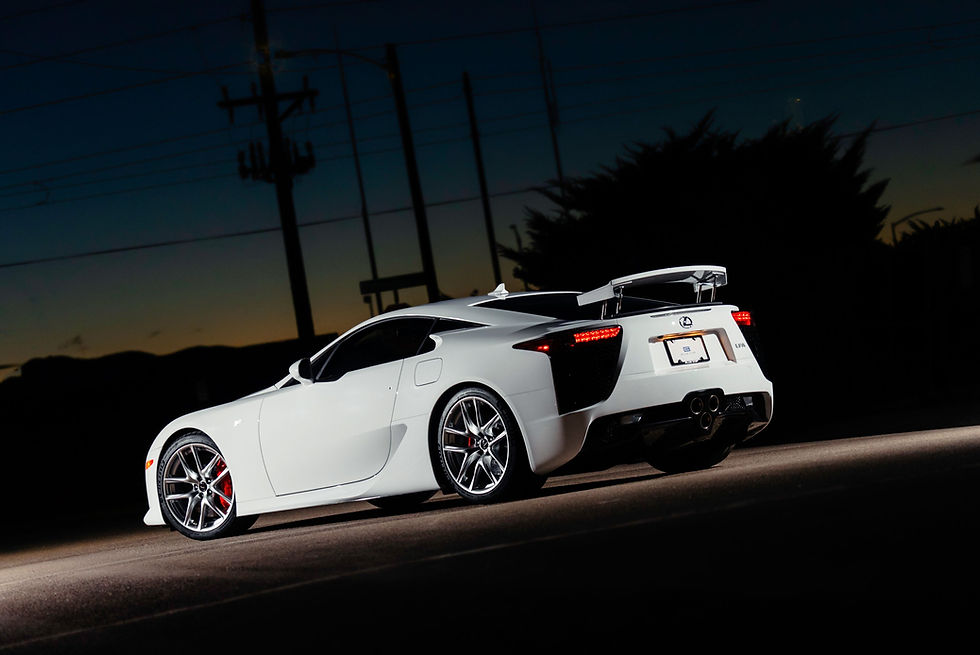The History and Evolution of Lexus
- Johnny Fast

- Jul 17, 2024
- 4 min read
Updated: Oct 16, 2024
Introduction
Lexus, the luxury vehicle division of the Japanese automaker Toyota, is renowned for its commitment to quality, reliability, and refined luxury. Since its inception, Lexus has grown into one of the most respected and best-selling luxury car brands globally. This article explores the history of Lexus, from its beginnings to its current lineup, highlighting the key figures and milestones that have shaped the brand into what it is today.
Lexus: The Beginning
Lexus was born out of a vision to create a luxury car that could rival the best from Europe and America. The project, initially known as the "F1" project (Flagship One), began in 1983 when Toyota’s then-chairman, Eiji Toyoda, challenged the company to build the world’s best car. This ambitious goal led to the creation of Lexus and the launch of its first vehicle, the Lexus LS 400, in 1989.
Key People Involved in the Early Years:
- Eiji Toyoda: As the chairman of Toyota, Toyoda was the driving force behind the creation of Lexus. His vision for a luxury brand that could compete globally set the foundation for the development of Lexus.
- Shoiji Jimbo and Ichiro Suzuki: Chief engineers on the Lexus LS 400 project, they played crucial roles in the meticulous development of the car, focusing on achieving new standards of quietness, comfort, and performance.
- Tatsuro Toyoda: The president of Toyota Motor Corporation during the launch of Lexus, he oversaw the brand’s introduction to the U.S. market and its early expansion.
The Lexus Lineup: From Inception to Expansion
Lexus debuted with two models, the LS 400 and the ES 250, which quickly established the brand's reputation for luxury, reliability, and customer service.
Starting Lineup (1989):
1. Lexus LS 400: The flagship model and the cornerstone of the Lexus brand, the LS 400 was a full-size luxury sedan that offered a smooth ride, advanced technology, and an unparalleled level of refinement. It was powered by a 4.0-liter V8 engine and was celebrated for its quietness and comfort.
2. Lexus ES 250: A mid-size luxury sedan based on the Toyota Camry platform, the ES 250 was designed to offer a more affordable entry point into the Lexus brand. It provided a combination of comfort, reliability, and value that appealed to a broad range of customers.
Expansion and Innovation: The Present and Future of Lexus
Since its debut, Lexus has expanded its lineup to include a wide range of luxury vehicles, from sedans and SUVs to hybrid and electric models. The brand has also become known for its pioneering work in hybrid technology, with the introduction of the world’s first luxury hybrid vehicle, the Lexus RX 400h, in 2005.
Present Lineup (As of 2024):
1. Lexus LS: The latest iteration of the flagship sedan, the LS, continues to represent the pinnacle of Lexus luxury, featuring advanced technology, hybrid options, and a design that emphasizes comfort and sophistication.
2. Lexus ES: The ES remains a core model for Lexus, offering a balance of luxury, comfort, and value. It has evolved over the years to include hybrid variants, catering to the increasing demand for eco-friendly vehicles.
3. Lexus RX: One of the brand’s best-selling models, the RX is a mid-size luxury SUV that offers a blend of performance, comfort, and practicality. The RX now comes in both hybrid and plug-in hybrid variants, highlighting Lexus’s commitment to sustainability.
4. Lexus NX: A compact luxury SUV, the NX is designed for urban driving with a focus on style, technology, and efficiency. The NX offers both hybrid and plug-in hybrid options, catering to a diverse customer base.
5. Lexus GX: A rugged, off-road-capable luxury SUV, the GX combines the brand’s signature luxury with the ability to handle challenging terrains, making it a popular choice for adventurous drivers.
6. Lexus LX: The full-size luxury SUV, the LX, is known for its off-road prowess and opulent interior, appealing to those who need both luxury and capability in one package.
7. Lexus LC: A grand touring coupe, the LC is a showcase of Lexus’s design and engineering capabilities, offering a high-performance driving experience wrapped in a stunning design.
8. Lexus IS: A compact luxury sports sedan, the IS is designed for driving enthusiasts, offering sharp handling, aggressive styling, and a choice of powerful engines.
9. Lexus UX: The UX is a subcompact luxury crossover aimed at urban dwellers, offering a mix of practicality, style, and efficiency, with hybrid versions available.
10. Lexus RZ: The brand’s first fully electric vehicle, the RZ, marks Lexus’s entry into the electric luxury vehicle market, aligning with its long-term vision for sustainable mobility.
Key Figures in the Present:
- Koji Sato: The current President of Lexus International, Sato has been instrumental in steering Lexus towards a future focused on electrification and sustainability while maintaining the brand’s core values of quality and luxury.
- Yoshihiro Sawa: Former President of Lexus International, Sawa played a key role in expanding the global footprint of Lexus and introducing the brand’s new design language, "L-Finesse."
- Akio Toyoda: The current chairman of Toyota Motor Corporation and a major influence on Lexus’s development strategy, particularly its push towards electrification and performance-oriented models like the Lexus F series.
Conclusion
Lexus has come a long way since its inception in 1989. From a single luxury sedan to a diverse lineup of vehicles catering to different segments of the luxury market, Lexus has maintained its commitment to quality, innovation, and customer satisfaction. As the brand continues to evolve, with a strong focus on electrification and sustainability, it remains a benchmark for luxury and reliability in the automotive industry. The story of Lexus is one of relentless pursuit of perfection, and its future looks just as promising as its past.
➱ Company Website: LEXUS
COPYRIGHT/DISCLAIMER:
REPORT ERRORS or ADD INFORMATION:


